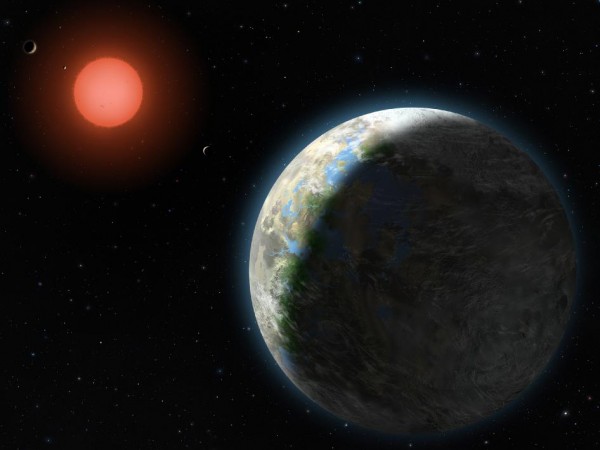Study: First Habitable Earth-like Exoplanet Found Might be Habitable After All
| Ana Verayo | | Mar 10, 2015 08:58 AM EDT |
(Photo : Lynette Cook/NASA) This artist's conception shows the inner four planets of the Gliese 581 system and its host star, a red dwarf star only 20 light years away from Earth.
Scientists have always been searching for elusive habitable Earth-like exoplanets and there's apparently one "habitable" planet scientists previously ignored due to inadequate data analysis.
This Earth-like exoplanet called GJ 581d was first spotted in 2009 in the star system Gliese 581 estimated just 20 light years away from our planet.
Like Us on Facebook
This planet was detected using the HIRES spectrometer of the Keck I telescope that measured its Doppler shift, or the wavelength of light emitted by a star caused by an orbiting planet when it passes in front of that star.
There were already initial observations that indicated GJ 581d has a surface temperature cool enough for water to exist on its surface and possibly support microbial life. Unfortunately, scientists didn't think this planet was habitable enough and considered this discovery just "noise" found in astronomical data sets and not due to the presence of a habitable world.
Now, researchers from the Queen Mary University of London (QMUL) and the University of Hertfordshire believe GJ 581d is truly a habitable exoplanet and that scientists were actually right in supposing it was when they first discovered GJ 581d.
According to lead researcher Guillem Anglada-Escudé, the existence of GJ 581d will always be significant since it's the first planet found in the "Goldilocks Zone" or the habitable zone in another star system and has been the benchmark case for the Doppler method.
The statistical technique used by scientists during a 2014 research created a discrepancy, especially for detecting smaller planets. The Doppler technique has been effective for larger planets in the past since their effect on their host star is too strong to ignore.
Since GJ 581 is a relatively small planet, it has been challenging for researchers to find the smallest or faintest planet signals that are too close or within the stellar noise caused by its host star's interaction and variability.
The QMUL team used a more accurate model with existing data and reclassified GJ 581d as one of the most probable existing exoplanets similar to ours outside the solar system.
This study was published in the journal, Science.
TagsStudy: First Ever Habitable Earth-like Exoplanet Found Might Exist After All, gliese 581, habitable exoplanets, earth-like planets, earth like habitable planet found discovered
©2015 Chinatopix All rights reserved. Do not reproduce without permission
EDITOR'S PICKS
-

Did the Trump administration just announce plans for a trade war with ‘hostile’ China and Russia?
-

US Senate passes Taiwan travel bill slammed by China
-

As Yan Sihong’s family grieves, here are other Chinese students who went missing abroad. Some have never been found
-

Beijing blasts Western critics who ‘smear China’ with the term sharp power
-

China Envoy Seeks to Defuse Tensions With U.S. as a Trade War Brews
-

Singapore's Deputy PM Provides Bitcoin Vote of Confidence Amid China's Blanket Bans
-

China warns investors over risks in overseas virtual currency trading
-

Chinese government most trustworthy: survey
-

Kashima Antlers On Course For Back-To-Back Titles
MOST POPULAR
LATEST NEWS
Zhou Yongkang: China's Former Security Chief Sentenced to Life in Prison

China's former Chief of the Ministry of Public Security, Zhou Yongkang, has been given a life sentence after he was found guilty of abusing his office, bribery and deliberately ... Full Article
TRENDING STORY

China Pork Prices Expected to Stabilize As The Supplies Recover

Elephone P9000 Smartphone is now on Sale on Amazon India

There's a Big Chance Cliffhangers Won't Still Be Resolved When Grey's Anatomy Season 13 Returns

Supreme Court Ruled on Samsung vs Apple Dispute for Patent Infringement

Microsoft Surface Pro 5 Rumors and Release Date: What is the Latest?










